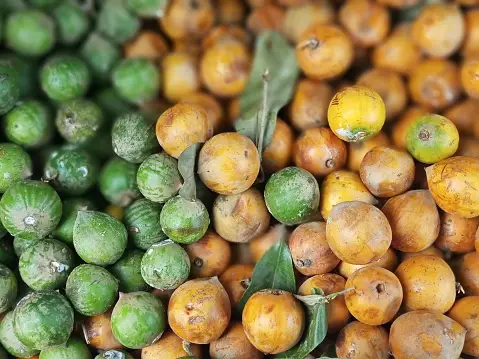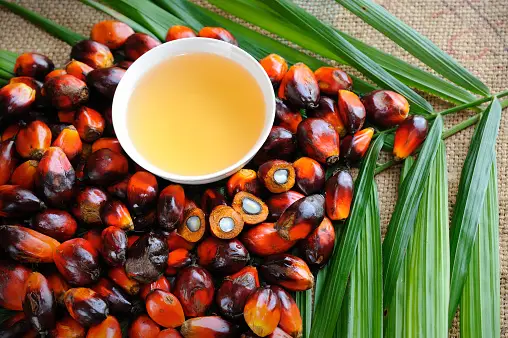Semolina flour is made from a wheat called durum wheat. It has a slightly coarse texture and a pale yellow color. Semolina is used in cooking and baking. It’s often used to make pasta, couscous, and various types of bread. Semolina’s unique texture and flavor make it a versatile ingredient in savoury and sweet dishes.
When should you introduce solid food to babies?
Introducing solid foods to babies around the age of 6 months is generally recommended. Babies usually have the necessary developmental skills to handle and digest solid foods at this stage. Starting with simple and easily digestible foods, such as mashed fruits, vegetables, or infant cereals, is important. Gradually introduce new foods and textures while closely monitoring for any signs of allergies or digestive issues.
Health benefits of semolina for babies 6 months old and above
- Nutrient-rich: Semolina is a good source of essential nutrients like carbohydrates, protein, and fiber, which are necessary for a baby’s growth and development.
- Energy boost: The high carbohydrate content in semolina provides a quick and sustained energy boost for active babies.
- Digestive health: The fiber in semolina promotes healthy digestion and helps prevent constipation, a common issue in babies.
- Iron source: Semolina contains iron, an essential mineral that supports the production of red blood cells and helps prevent iron deficiency anemia in babies.
- Easy to digest: Semolina has a fine, easily digestible texture, making it suitable for babies transitioning to solid foods.
- Versatile ingredient: Semolina can make various nutritious dishes like porridge, puddings, and homemade baby cereals, providing a wholesome and tasty addition to your baby’s diet.
Can semolina cause constipation in babies over 6 months old?
Semolina may cause constipation in babies if not prepared or introduced correctly. While semolina is not typically known to cause constipation, factors such as insufficient fluid intake or inadequate fiber in the overall diet can contribute to constipation. I
It’s important to ensure that your baby is getting enough fluids and a well-balanced diet that includes a variety of fruits, vegetables, and other sources of fiber.
How to make semolina for babies under 12 months
- Select a high-quality, finely ground semolina specifically designed for babies. Look for a trusted brand that offers semolina suitable for infants.
- In a clean saucepan, bring water to a boil. The water-to-semolina ratio should be approximately 4 parts water to 1 part semolina.
- Gradually add the semolina to the boiling water while stirring continuously. This helps prevent the formation of lumps and ensures a smooth texture.
- Reduce the heat to low and let the semolina cook for 5-7 minutes. Stir from time to time to prevent sticking.
- If desired, you can enhance the flavour and nutritional value of the semolina by adding breast milk, formula, or a small amount of fruit puree. This can introduce new flavors and provide additional nutrients to your baby’s meal.
- Allow the semolina to cool before serving it to your baby. Ensure it is at an appropriate temperature that won’t cause discomfort or harm to your little one’s delicate mouth.
Safety measures when preparing semolina for babies under 12 months
- Ensure proper hygiene: Wash your hands thoroughly before handling ingredients or preparing the semolina. Clean and sanitize all utensils, bowls, and cooking equipment used.
- Choose suitable ingredients: Select semolina specifically made for babies, as it is finely ground and more accessible for them to digest. Use clean and fresh water for cooking, and if adding breast milk, formula, or fruit puree, ensure they are safe and suitable for your baby’s age and dietary needs.
- Cook thoroughly: Cook the semolina to a soft and easily chewable consistency. It helps to prevent any choking hazards for your baby.
- Test the temperature: Before serving, check the temperature of the semolina to ensure it is neither too hot nor too cold. It should be lukewarm to avoid discomfort or burns to your baby’s mouth.
- Always supervise: Feed your baby upright and closely supervise them during mealtime. This helps prevent choking and ensures they are eating safely.
Side effects of semolina for babies under 12 months
Semolina is generally safe for babies when prepared and introduced appropriately. However, it’s important to note that every baby is different; some may have specific sensitivities or allergies. If you notice any adverse reactions such as digestive issues, rashes, or discomfort after introducing semolina to your baby, it’s best to consult with a pediatrician for personalized advice.
Semolina is a nutrient-rich option for introducing solid foods to babies around 6 months of age and above. It offers essential nutrients, aids digestion, and provides a versatile ingredient for various dishes. However, preparing and introducing semolina with care is crucial to prevent any potential digestive issues.
Always prioritize hygiene, choose suitable ingredients, and supervise mealtime. If any adverse reactions occur, consult a pediatrician for personalized guidance. Remember, every baby is unique, and their dietary needs may vary.
Frequently Asked Questions (FAQs)
Can I give my baby semolina?
You can give your baby semolina as long as they are 6 months old and above. Ensure it’s appropriately prepared and introduced gradually as part of a balanced diet.
Can semolina cause constipation in a 6-month-old baby?
Semolina itself is not known to cause constipation in babies. However, if your baby experiences constipation after consuming semolina, it could be due to other factors, such as insufficient water intake or individual sensitivity.
Can my 6-month-old baby take semolina and milk?
At 6 months old, your baby can have semolina mixed with milk. It is very nutritious and tasty.










Comments